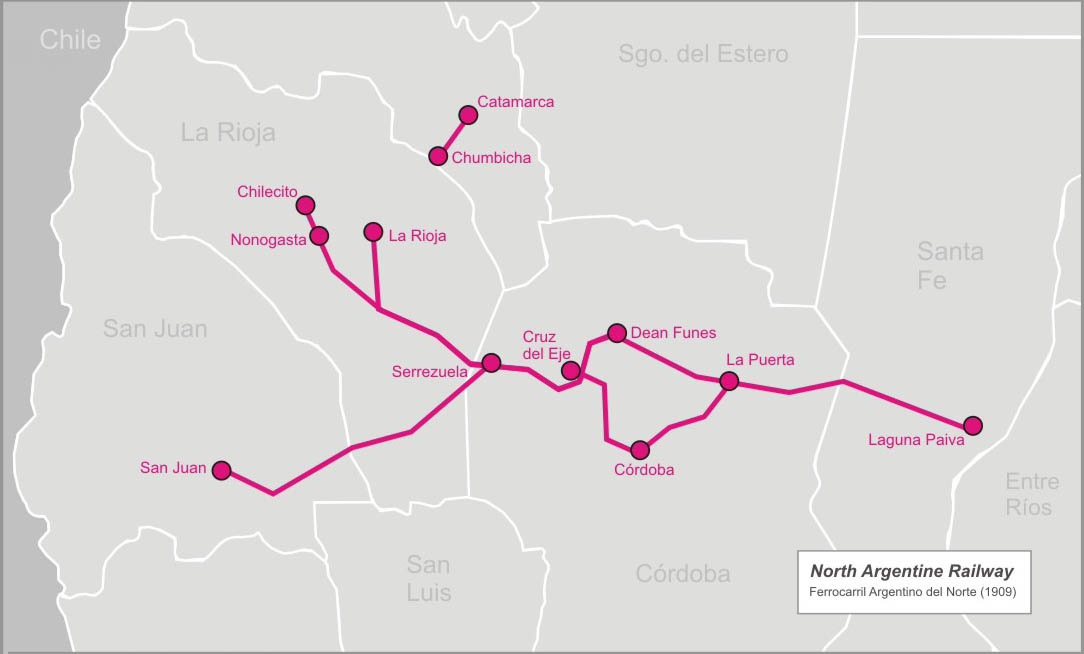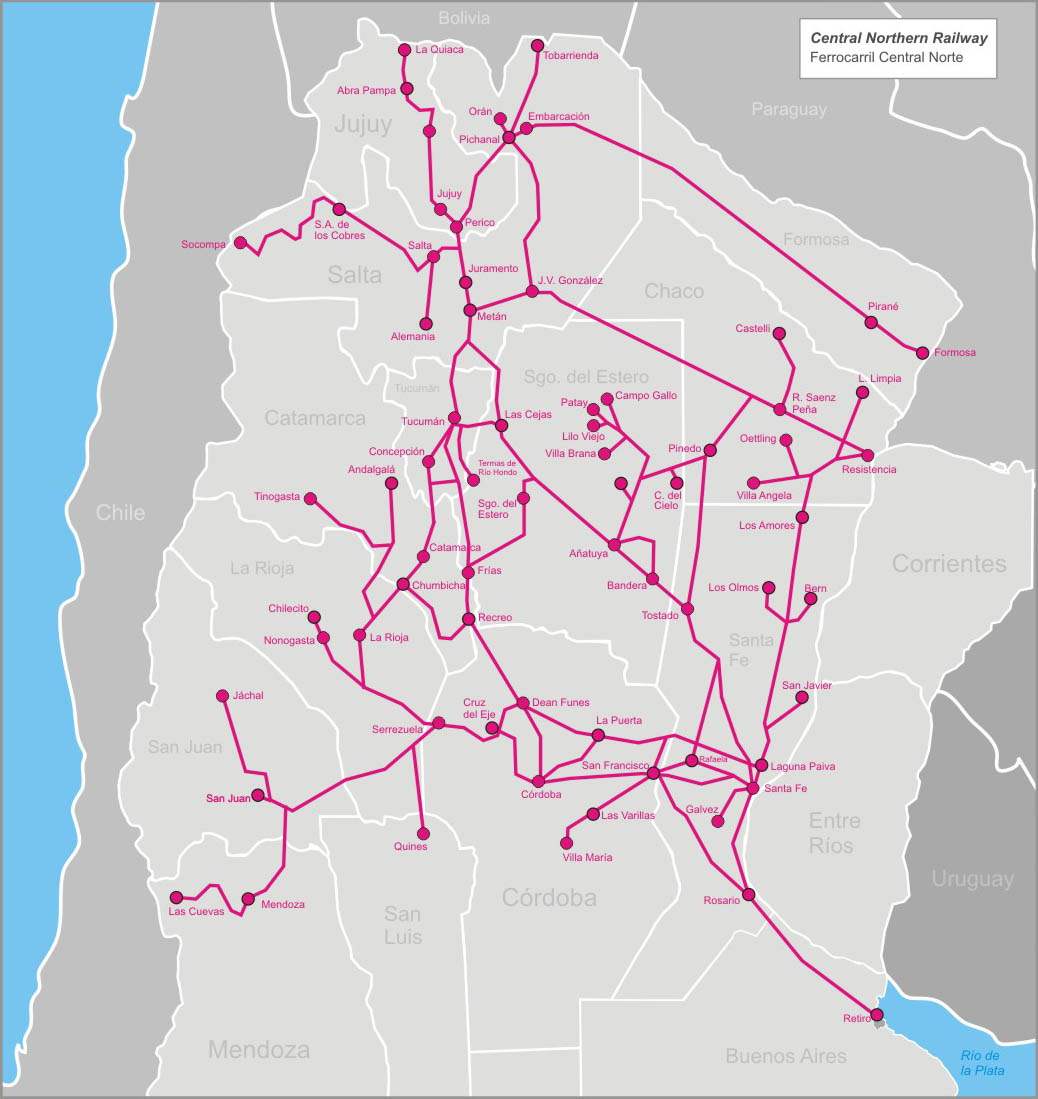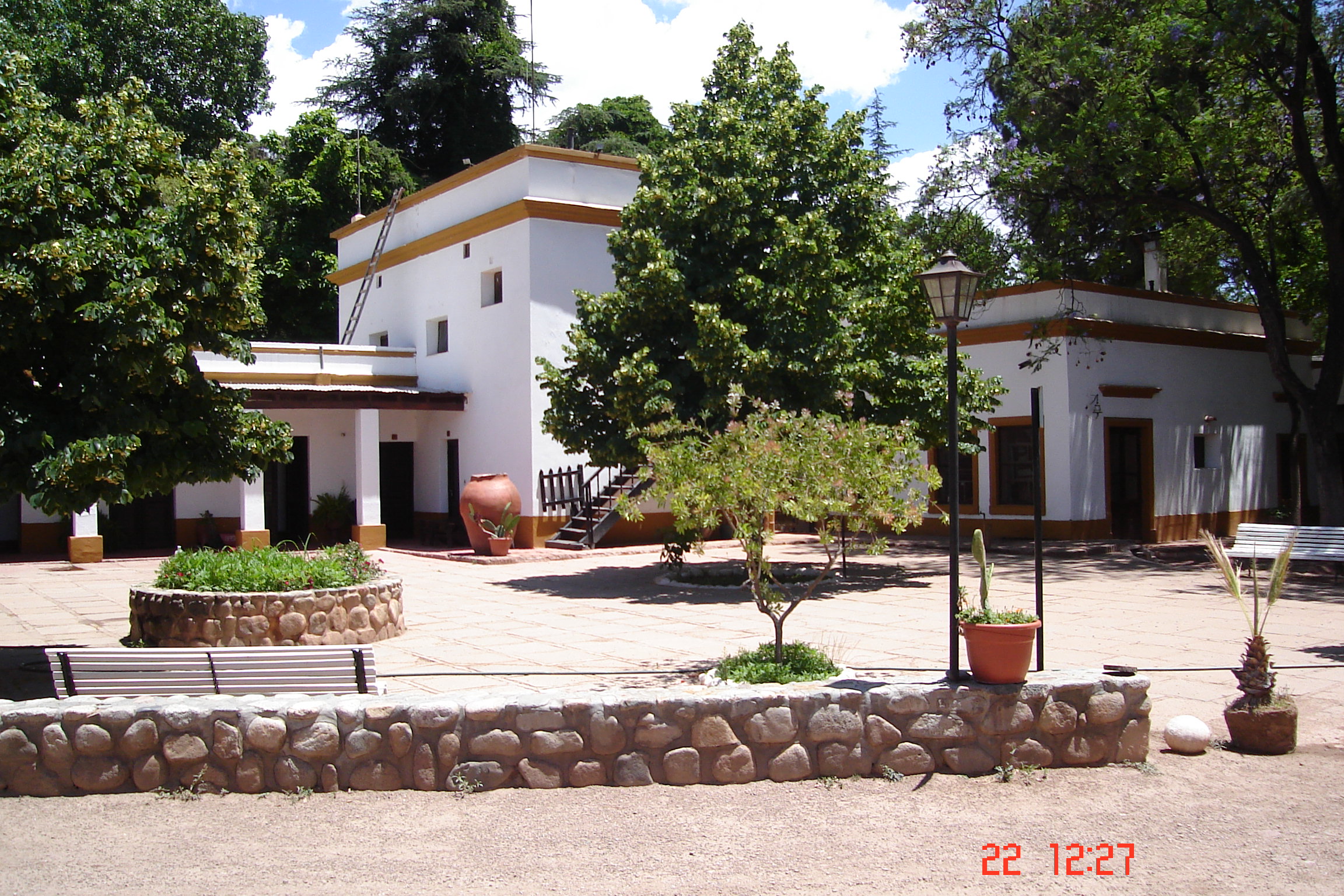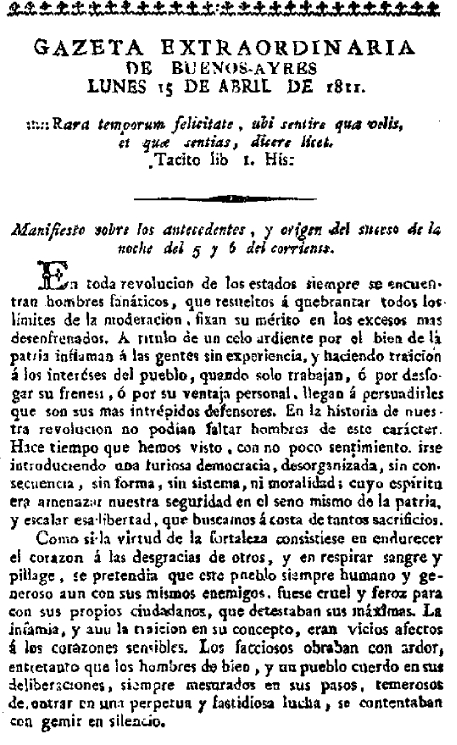|
North Argentine Railway
The North Argentine Railway (native name: Ferrocarril Argentino del Norte) was a State-owned railway company which built a ( metre gauge) railway network in the Argentine provinces of Catamarca and Córdoba which was later merged with the state-owned Ferrocarril Central Norte in 1909. On 8 June 1889 a line between Chumbicha and Catamarca in Catamarca Province was opened by the state-owned company "Ferrocarril Chumbicha a Catamarca". Another state company, "Ferrocarril Deán Funes a Chilecito", completed a line between Deán Funes and Paso Viejo on 29 March 1890. The line was then extended to Patquia and finally to La Rioja in 1897. On 1 January 1898 these two railway companies were renamed "North Argentine Railway" (NAR) and on 23 June of the same year the section from Patquia to Chilecito was opened. The section from Chumbicha to La Rioja was opened on 1907 and on 11 October 1909, following the creation of the Argentine State Railway ("Ferrocarriles del Estado"), the ... [...More Info...] [...Related Items...] OR: [Wikipedia] [Google] [Baidu] |
Inter-city Rail
Inter-city rail services are express passenger train services that run services that connect cities over longer distances than commuter or regional trains. There is no precise definition of inter-city rail; its meaning may vary from country to country. Most broadly, it can include any rail services that are neither short-distance commuter rail trains within one city area, nor slow regional rail trains calling at all stations and covering local journeys only. Most typically, an inter-city train is an express train with limited stops and comfortable carriages to serve long-distance travel. Inter-city rail sometimes provides international services. This is most prevalent in Europe, due to the close proximity of its 50 countries in a 10,180,000 square kilometre (3,930,000 sq mi) area. Eurostar and EuroCity are examples of this. In many European countries the word "InterCity" or "Inter-City" is an official brand name for a network of regular-interval, relatively long-distance ... [...More Info...] [...Related Items...] OR: [Wikipedia] [Google] [Baidu] |
San Fernando Del Valle De Catamarca
San Fernando del Valle de Catamarca () is the capital and largest city in Catamarca Province in Argentine Northwest, northwestern Argentina, on the Río Valle River, at the feet of the Cerro Ambato. The city name is normally shortened as Catamarca. The city of , located above sea level, has 159,000 inhabitants (), with more than 200,000 counting the suburbia, what represents around 70% of the population of the province. Overview The city is located from Buenos Aires. The closest provincial capitals are La Rioja, Argentina, La Rioja (), San Miguel de Tucumán, Tucumán () and Santiago del Estero (). Many pilgrims come to San Fernando del Valle de Catamarca to visit the Church of the Virgin of the Valley (1694), which contains a statue of ''Nuestra Señora'' del Valle (Our Lady of the Valley). Catamarca is also the touristic centre of the province, with its colonial architecture, and serves as a hub to many touristic points and excursions, hiking, mountain-bike tours, horse r ... [...More Info...] [...Related Items...] OR: [Wikipedia] [Google] [Baidu] |
Transport In La Rioja Province, Argentina
Transport (in British English), or transportation (in American English), is the intentional Motion, movement of humans, animals, and cargo, goods from one location to another. Mode of transport, Modes of transport include aviation, air, land transport, land (rail transport, rail and road transport, road), ship transport, water, cable transport, cable, pipeline transport, pipeline, and space transport, space. The field can be divided into infrastructure, vehicles, and business operations, operations. Transport enables human trade, which is essential for the development of civilizations. Transport infrastructure consists of both fixed installations, including roads, railways, airway (aviation), airways, waterways, canals, and pipeline transport, pipelines, and terminals such as airports, train station, railway stations, bus stations, warehouses, trucking terminals, refueling depots (including fueling docks and fuel stations), and seaports. Terminals may be used both for intercha ... [...More Info...] [...Related Items...] OR: [Wikipedia] [Google] [Baidu] |
Metre Gauge Railways In Argentina
The metre (British spelling) or meter (American spelling; see spelling differences) (from the French unit , from the Greek noun , "measure"), symbol m, is the primary unit of length in the International System of Units (SI), though its prefixed forms are also used relatively frequently. The metre was originally defined in 1793 as one ten-millionth of the distance from the equator to the North Pole along a great circle, so the Earth's circumference is approximately km. In 1799, the metre was redefined in terms of a prototype metre bar (the actual bar used was changed in 1889). In 1960, the metre was redefined in terms of a certain number of wavelengths of a certain emission line of krypton-86. The current definition was adopted in 1983 and modified slightly in 2002 to clarify that the metre is a measure of proper length. From 1983 until 2019, the metre was formally defined as the length of the path travelled by light in a vacuum in of a second. After the 2019 redefiniti ... [...More Info...] [...Related Items...] OR: [Wikipedia] [Google] [Baidu] |
Railway Companies Disestablished In 1909
Rail transport (also known as train transport) is a means of transport that transfers passengers and goods on wheeled vehicles running on rails, which are incorporated in tracks. In contrast to road transport, where the vehicles run on a prepared flat surface, rail vehicles (rolling stock) are directionally guided by the tracks on which they run. Tracks usually consist of steel rails, installed on sleepers (ties) set in ballast, on which the rolling stock, usually fitted with metal wheels, moves. Other variations are also possible, such as "slab track", in which the rails are fastened to a concrete foundation resting on a prepared subsurface. Rolling stock in a rail transport system generally encounters lower frictional resistance than rubber-tyred road vehicles, so passenger and freight cars (carriages and wagons) can be coupled into longer trains. The operation is carried out by a railway company, providing transport between train stations or freight customer faciliti ... [...More Info...] [...Related Items...] OR: [Wikipedia] [Google] [Baidu] |
Railway Companies Established In 1898
Rail transport (also known as train transport) is a means of transport that transfers passengers and goods on wheeled vehicles running on rails, which are incorporated in tracks. In contrast to road transport, where the vehicles run on a prepared flat surface, rail vehicles (rolling stock) are directionally guided by the tracks on which they run. Tracks usually consist of steel rails, installed on sleepers (ties) set in ballast, on which the rolling stock, usually fitted with metal wheels, moves. Other variations are also possible, such as "slab track", in which the rails are fastened to a concrete foundation resting on a prepared subsurface. Rolling stock in a rail transport system generally encounters lower frictional resistance than rubber-tyred road vehicles, so passenger and freight cars (carriages and wagons) can be coupled into longer trains. The operation is carried out by a railway company, providing transport between train stations or freight customer facilit ... [...More Info...] [...Related Items...] OR: [Wikipedia] [Google] [Baidu] |
Defunct Railway Companies Of Argentina
{{Disambiguation ...
Defunct (no longer in use or active) may refer to: * ''Defunct'' (video game), 2014 * Zombie process or defunct process, in Unix-like operating systems See also * * :Former entities * End-of-life product * Obsolescence Obsolescence is the state of being which occurs when an object, service, or practice is no longer maintained or required even though it may still be in good working order. It usually happens when something that is more efficient or less risky r ... [...More Info...] [...Related Items...] OR: [Wikipedia] [Google] [Baidu] |
General Belgrano Railway
The General Manuel Belgrano Railway (FCGMB) (Spanish: Ferrocarril General Manuel Belgrano), named after the Argentine politician and military leader Manuel Belgrano, is a railway and the longest of the Argentine system. It was one of the six State-owned Argentine railway companies formed after President Juan Perón's nationalisation of the railway network in 1948. Retiro station is the railway's terminus in Buenos Aires, from which the railway runs to many provinces in the Centre and North of Argentina, such as Santa Fe, Córdoba, Tucumán, La Rioja, Catamarca, Chaco, Santiago del Estero, Salta and Jujuy. In the metropolitan section of the city of Buenos Aires, Ferrocarril Belgrano is divided into two lines, Belgrano Norte and Belgrano Sur, currently operated by Private companies Ferrovías and Argentren respectively. Passenger trains of Norte Line are only run to Villa Rosa in Pilar Partido. From then on, freight services run to the rest of the network, operated by ... [...More Info...] [...Related Items...] OR: [Wikipedia] [Google] [Baidu] |
Argentine State Railway
Argentine State Railway (in Spanish: Ferrocarriles del Estado) was a State-owned railway company of Argentina, established by Law N° 6.757 in October 1909, when José Figueroa Alcorta was the President of Argentina. The company built and operated railway lines in Argentina. History By 1905 the State-owned railway network was 3,490 km length, with the Ferrocarril Central Norte (FCN) being the longest with 1,385 km and the Ferrocarril Argentino del Norte (FAN) with 563 km. Five years later, FCN was 2,135 km long and FAN 1,355 km. In 1925, the Argentine State Railway ranked 2nd among the most important companies in the country, operating a railway network of 6,617 km. By 1936 the railway network had been extended to 9,690 km. Most of the railway lines built by the Argentine state were metre gauge because of financial reasons. In 1937 the State company began to acquire some existing companies with the purpose of competing against British railw ... [...More Info...] [...Related Items...] OR: [Wikipedia] [Google] [Baidu] |
Chilecito
Chilecito is a city in the Argentine province of La Rioja, and head of the department of Chilecito. Overview The city is located in the valley formed by the ''Sierras de Velazco'' to the east, and the ''Sierras de Famatina'' to the west. The city was founded in 1715 by Spanish colonizers. Chilecito still preserves the cable-car of ''La Mejicana'' mine built by Bleichert which is part of the city mining past that saw its peak at the end of the 19th century. Chilecito is surrounded by an oasis of irrigation, which has been expanded by way of supplements from underground waters. A great part of agricultural land is used for the cultivation of vineyards because the most significant industrial activity is based in wine-cellars. Walnut and fruit trees are also cultivated and their product is locally processed. The Argentine educator, lawyer, senator, governor and historian Joaquín V. González was raised in the vicinity of Chilecito. He also used to spend his vacation in a home th ... [...More Info...] [...Related Items...] OR: [Wikipedia] [Google] [Baidu] |
La Rioja Province (Argentina)
La Rioja () is a province of Argentina located in the west of the country. The landscape of the province consist of a series of arid to semi-arid mountain ranges and agricultural valleys in between. It is in one of these valleys that the capital of the province, the city of la La Rioja, lies. Neighboring provinces are from the north clockwise Catamarca, Córdoba, San Luis and San Juan. The dinosaur '' Riojasaurus'' is named after the province. History Petroglyphs created by early indigenous peoples at the Talampaya National Park are dated around 10,000 years BC. Succeeding cultures of indigenous peoples developed here. The Diaguita, Capayan and the Olongasta peoples inhabited the territory of present-day La Rioja Province at the time of encounter with the Spanish colonists in the 16th century. Juan Ramírez de Velazco founded ''Todos Los Santos de la Nueva Rioja'' in 1591 under the government of Tucumán of the Viceroyalty of Peru. In 1630 the Calchaquí people revolted ... [...More Info...] [...Related Items...] OR: [Wikipedia] [Google] [Baidu] |
Deán Funes
Gregorio Funes (May 25, 1749 – January 10, 1829), also known as ''Deán Funes'', was an Argentine clergyman, educator, historian, journalist and lawmaker who played a significant role in his nation's early, post-independence history. Biography Early life and the priesthood Funes' parents were Juan José Funes y Ludueña, and María Josefa Bustos de Lara. The Funes family had arrived to Córdoba with the first group of settler led by Jerónimo Luis de Cabrera, and the Bustos family was part of a group of Spanish colonists that left Chile and moved to Mendoza and Córdoba. Born in Córdoba, in what was then the Governorate of the Río de la Plata (a part of the Spanish Empire), Gregorio Funes was raised in privileged circumstances, and enrolled at the College of Monserrat. He studied in cloistered conditions, and shared his formative years with Juan José Castelli or Juan José Paso. Funes was ordained into the priesthood in 1773, and was named head seminarian; he graduated th ... [...More Info...] [...Related Items...] OR: [Wikipedia] [Google] [Baidu] |








